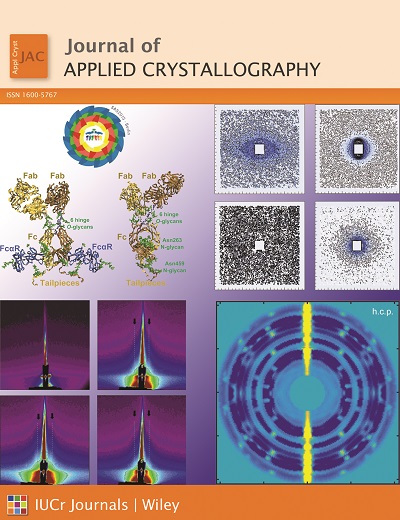Small-angle scattering
 The 16th International Conference on Small-Angle Scattering
(SAS2015) was held in Berlin, Germany, in
2015. A fully open-access virtual special edition
of Journal of Applied Crystallography
publishes work that provides insights into ongoing developments in the field of
small-angle neutron and X-ray scattering (SANS and SAXS) covering different
areas of fundamental and applied research. Some of the highlights from the
issue include a paper from Lehmkühler et al. (2016) which describes the use of
X-ray cross correlation analysis applied to the investigation of colloidal
crystals. For the case of poly(methyl methacrylate) colloids it is shown how
information beyond the static structure factor can be deduced from coherent
X-ray scattering experiments, for example, enabling assignment of a
face-centred cubic structure to the crystal. In a different direction the work
by Perkins et al. (2016) dwells on the current state of the atomistic modelling
of scattering data and reviews the achievement of the Collaborative
Computational Project for Small Angle Scattering (CCP-SAS). Certainly these
developments will be important for the future when increasingly complex systems
will probably need to be characterised by SAS with atomistic resolution.
The 16th International Conference on Small-Angle Scattering
(SAS2015) was held in Berlin, Germany, in
2015. A fully open-access virtual special edition
of Journal of Applied Crystallography
publishes work that provides insights into ongoing developments in the field of
small-angle neutron and X-ray scattering (SANS and SAXS) covering different
areas of fundamental and applied research. Some of the highlights from the
issue include a paper from Lehmkühler et al. (2016) which describes the use of
X-ray cross correlation analysis applied to the investigation of colloidal
crystals. For the case of poly(methyl methacrylate) colloids it is shown how
information beyond the static structure factor can be deduced from coherent
X-ray scattering experiments, for example, enabling assignment of a
face-centred cubic structure to the crystal. In a different direction the work
by Perkins et al. (2016) dwells on the current state of the atomistic modelling
of scattering data and reviews the achievement of the Collaborative
Computational Project for Small Angle Scattering (CCP-SAS). Certainly these
developments will be important for the future when increasingly complex systems
will probably need to be characterised by SAS with atomistic resolution.
SAS has become increasingly important over the years for the investigation of soft matter systems. An interesting example of such an investigation is given by Prevost et al. (2016), which successfully shows how to obtain detailed structural information on so-called “ultra-flexible microemulsions”. This is a novel type of self-assembled system that exhibits microemulsion structures even in the absence of a typical surfactant, as was elucidated here using a combination of SAXS and wide-angle X-ray scattering.
Synthetic systems can also be of high scientific interest as demonstrated in a paper by Kaneko et al. (2016) in the case of syndiotactic polystyrene cocrystals with polyethylene glycol dimethyl ether. The temperature-dependent changes from crystalline to more amorphous structures were obtained by combining SANS investigations with simultaneous Fourier transform infrared spectroscopy measurements.
Another way of coupling SAS experiments with complementary information is shown by Jordan et al. (2016), who demonstrate how size exclusion chromatography (SEC) can be coupled to SANS experiments. Instrumentation is also the focus of Li et al. (2016), who report on the state of the BioSAXS beamline BL19U2 at the National Centre for Protein Sciences Shanghai. This new synchrotron SAXS beamline is dedicated to meeting the increasing demands of researchers from the field of structural biology.
The topics contained in the special issue describe the particular directions in which SAS is developing at the moment and which will become increasingly important in the future. There will no doubt be further substantial advances of the SAS technique, itself, and its application to solve important scientific questions in diverse research areas.
This is a short extract taken from an editorial published in J. Appl. Cryst. (2016), 49, 1858-1860

